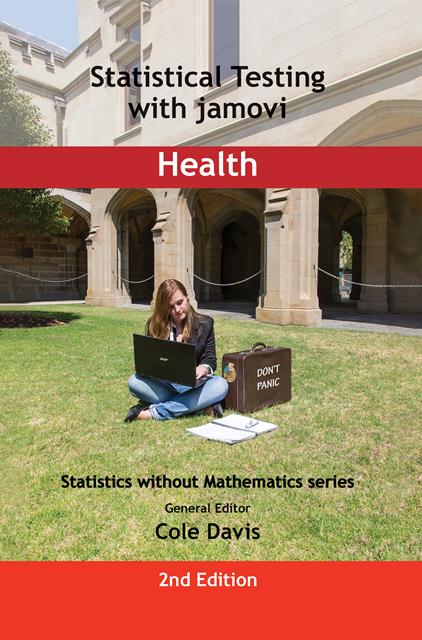|
| Home |
| Order books |

|
Statistical Testing with jamovi for Health
Statistical Testing with jamovi for Health
Exercises and case studies
Chapter 8 in the book contains basic exercises covering all of Section 2. Diverse tutors, however, have asked for traditional chapter by chapter exercises, hence the table immediately below. Further down the page, case studies are presented for readers who have finished reading the whole book, or their tutors.Exercises
These chapter by chapter exercises have been contributed by Marianne Vitug. For each chapter is a document with the questions, and one with the answers, with relevant spreadsheet files (with the .csv suffix). Each page opens in a new tab of your browser.
| Ch 2 Research design | Questions | Answer | self-entry |
| Ch 3 Descriptive statistics | Questions | Answers | data file 0 |
| Ch 4 Null hypothesis significance testing | Questions | Answers | data file 0 |
| Ch 5 Tests of differences | Questions | Answers | data file 1 |
| Ch 5 Tests of differences | data file 2 | ||
| Ch 5 Tests of differences | data file 3 | ||
| Ch 5 Tests of differences | data file 4 | ||
| Ch 6 Tests of relationships | Questions | Answers | data file |
| Ch 7 Categorical analyses | Questions | Answers | data file |
| Ch 10 Factorial ANOVA | Questions | Answers | data file 1 |
| Ch 10 Factorial ANOVA | data file 2 | ||
| Ch 10 Factorial ANOVA | data file 3 | ||
| Ch 11 ANCOVA | Questions | Answers | data file |
| Ch 12 MANOVA | Questions | Answers | data file |
| Ch 13 PCA and factor analysis | Questions | Answers | data file 1 |
| Ch 13 PCA and factor analysis | data file 2 | ||
| Ch 14 Logistic regression | Questions | Answers | data file |
| Ch 15 Partial correlations | Questions | Answers | data file |
| Ch 17 Bayesian statistics | Questions | Answers | data file |
| Ch 18 Survival analysis (Kaplan-Meier) | Questions | Answers | data file |
| Ch 19 Cluster analysis | Questions | Answers | data file |
Case studies
A range of information can be acquired from the surfaces of telephones, derived from mass spectrometry (Buschman H, 2016, What molecules you leave on your phone reveal about your lifestyle). You are interested in using such measures for learning more about contagion.
You have a large database comprising measures of health and wellbeing for older people. Your interest is in looking at common trends.
Do people who suffer severe psychological stress after loss of a loved one have different psychological characteristics from those bereaved people who do not require treatment? You believe that age, ethnicity and gender may also affect the classification.
Is a type of psychological therapy likely to differ in its effectiveness depending on the type of presenting problem? For example, if we used cognitive-behavioural therapy, would it have very different effects on people whose main symptoms were alcoholism, gambling addiction and panic attacks? Age, ethnicity and gender may affect the classification.
You are interested in the willingness of people to donate blood. Which attitudes lead to regular, occasional and no donations? You may wish to consider attributes such as the number of close relatives with a related condition or experience, the age and social class of the respondents.
What characteristics typify different levels of hospital administrator? Include gender and other demographic data as well as measurable attributes.
You are interested in how long it takes hospital patients with a specific health condition to become ready for discharge. Are there differences between age groups, or ethnicity, or attitudes to their condition, or whether or not they have regular visitors?
Three groups of adults with depression attend different clinics. One group receives CBT, another psychoanalysis and a third Rogerian therapy. Are there significant differences in remission symptoms and is there a difference between male and female patients?
Each year, over three years, a different health promotion is used about STDs. Each method is used in three different types of setting. By the end of the period, each setting would have experience all of the methods.
Doctors try out three different approaches for explaining important health problems to patients. Which works best, and are there differences dependent on doctors' personal attributes? (Or, perhaps, the patients' attributes.)
Are there particular categories of people who are more likely to catch covid?
(Assume that there is no knowledge of the topic.)
Statistics without Mathematics series - General Editor: Cole Davis
ISBN numbers: Hardback - 978-1-915500-12-0 Paperback - 978-1-915500-13-7 Ebook - 978-1-915500-14-4
